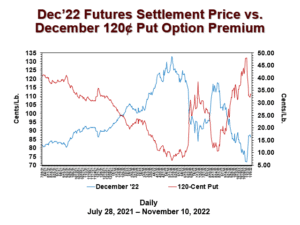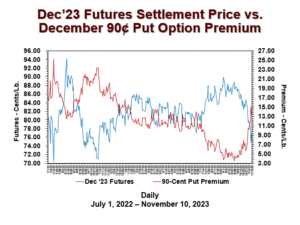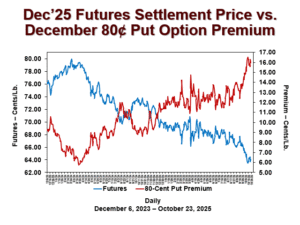Put options at a given strike price cost less (or more) in a rising (or falling) market because the the put option gives the right to have sold the underlying futures contract at a specified level. The example above looks back at the performance of a $1.20 put option on the expired Dec’22 futures contract. This option had intrinsic value when the underlying futures was below $1.20, like it was during the last half of 2022. Therefore, put option premiums move opposite of the direction of the underlying futures price. This is important because an increasing put option premium can act as an insurance payment against falling futures and (assuming a stable cash basis) falling cash prices.
Back when Dec’22 was trading at 120.10 cents per pound, the associated premium for a $1.20 put option was 10.41 cents per pound. Buying it at that level was essentially buying the right to a 109.59 cent short futures position. This implied a minimum cash price around 105 per pound with upside potential and no margin call exposure. Looking back, there were several opportunities in 2022 to buy affordable and meaningful put options. 2022 was unusual in that we saw two major declines of roughly 50 cents each in five months. This at least provides more awareness of the scope of downside price risk. (Want to see more? Click here to compare/contrast hedging opportunities with put options on ICE cotton futures over the last twenty years.)
2023 Example. Frequently, insurance doesn’t pay off. Hopefully that is true of our homeowner, auto, and life insurance. It’s also true of price insurance. For example, a 90-cent level put option on Dec’23 was fairly expensive throughout the planting/growing season of 2023. Buying a 90-put on that date implied a short hedged futures position in the mid-80s but without any margin exposure. Had there been a rally in Dec’23 futures into the low 90s, this simple hedging strategy might have become more affordable and relevant. But the sustained rally over 90 cents never happened. This is thus an example of buying insurance that did not have paid off, in contrast to 2022.
2024 Example. What about the 2024 crop season? In hindsight, the opportunity to insure against downside price risk with Dec’24 put options was back in March. When Dec’24 futures were bouncing off 85 cents per pound, a near-the-money 85 cent Dec’24 put option cost around six cents per pound. Purchasing it back then implied a short futures position around 79 cents per pound, with no margin exposure. With the decline in Dec’24 futures, this put option position has become more valuable, i.e., worth 14.02 cents per pound, as of November 8. That represents an 8 cent net gain in the option position, which is the partial insurance payment to compensate for the decline in both Dec’24 futures and your local cash price. With perfect hindsight, this position would have been cashed in when futures were below 70 cents (and the net option gain was 12 cents). This highlights the value of guidance by knowledge futures brokers/advisers in position management.
2025 Example. What about the current 2025 crop season? It is also too late in the year for this specific strategy to be sensible. In fact, the best this strategy could have done, if this put had been purchased back in March of 2024, i.e., with perfect hindsight, when Dec’25 futures was 79 cents and the put cost 6 cents, then the put premium would have more than doubled as Dec’25 futures fell. But this would have only covered the cost of the put, not buffered the decline in futures to that point. So this simple strategy would have been a questionable buy under these conditions. What to do? More complicated/risky strategies would have worked better, in hindsight.



